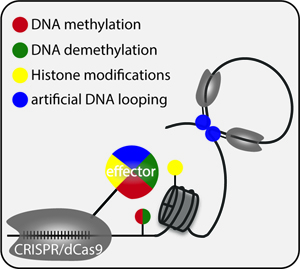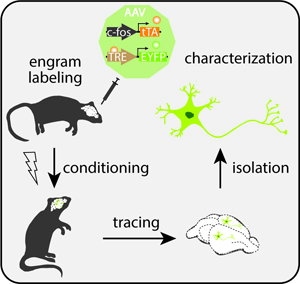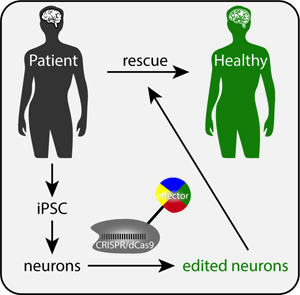| Home | |
| Faculty | |
| Graduate Program | |
| Events and Seminars | |
| Resources | |
| Contact Us | |
|
F A C U L T Y P R O F I L E
Current Research Our laboratory aims to decode the epigenome in physiology and diseases. We combine molecular tool development with genetic and genomic approaches to explore epigenetic mechanisms underlying normal physiological functions, and to uncover the epigenetic basis of diseases to accelerate the development of therapeutics. We mainly use human ESC- or iPSC-based system and genetically engineered mouse models to tackle these questions. Our three major research directions are listed below as 1) CRISPR-based epigenome editing tool development; 2) Molecular basis of memory storage; 3) Tackle human disease by sculpting epigenome. Epigenome Editing Tool Development Many breakthroughs in biomedical research were enabled by innovative technology and tool development, which is certainly applied to the field of epigenetics. Traditionally epigenetics is referred to the study of heritable changes of gene expression without altering the DNA sequence during cell proliferation and development. Several molecular mechanisms including DNA methylation, histone modifications, non-coding RNAs and 3D chromatin structures were identified to be responsible for a variety of intriguing epigenetic phenotypes observed in monocellular organisms such as yeast to multi-cellular organisms like human. For instance, epigenetic modifications undergo dynamic changes upon environmental stimuli, and are considered to enable the genome to interact with the environment (Jaenisch and Bird, 2003). With advances in next generation sequencing technologies, the study of epigenetics has been expanded into epigenome analysis focused on a multitude of chemical modifications and physical properties of the genome at a system level that control the functions of the genome (Bernstein et al., 2007). Numerous epigenetic changes have been associated with biological processes as well as pathological conditions. However, to distinguish the causality and correlation of these changes remains a challenge in this field. Development of epigenome editing tools enables a mechanistic dissection of the functional significance of individual epigenetic events. Our lab pioneered the CRISPR-based DNA methylation editing system including the fusion of a catalytically inactive Cas9 with DNMT3a and TET1 catalytic domains allowing for writing or erasing DNA methylation in the mammalian genome (Liu et al., 2016). The ease of assembly and versatility of CRISPR/dCas9 system to target epigenetic effector protein domains to any given locus allowed this approach to become available to the broad scientific community. We are now expanding the epigenome editing tool box to enable more options for epigenetic manipulations. Molecular Basis for Memory Storage A century ago Richard Semon coined the term of engram to describe a unit of cognitive information inside the brain by which memories are stored as biophysical or biochemical changes in the brain in response to external stimuli. Regardless of the terminology human memory can last for years, and thus the storage of long-term memory requires a self-perpetuation mechanism to overcome the relatively short half-life of most biomolecules, which range from several days to months. One provocative hypothesis is that DNA methylation contributes to the storage of memory. Indeed, DNA methylation in neurons changes during memory formation, and mutations in DNA methylation modification genes Dnmt or Tet disrupt learning and memory. However, limited insight into the neurons that encode memory made this hypothesis nearly untestable at the cellular level. Recently an activity-dependent strategy was used to successfully label the neurons encoding fear memory (Liu et al., 2012). We are collaborating with Steve Ramirez’s group at Boston University, co-first author of this labeling work, to investigate the role of DNA methylation in learning and memory. Tackle Diseases by Sculpting Epigenome
Many human diseases are intermingled by the genetic mutations and environmental influences. Brain, the most complex organ in humans, is vulnerable to genetic mutations as well as extreme environmental stimuli. As the coordinator between the genome and the environment, the epigenome undergoes dynamic changes during brain activities. Several epigenetic modifier genes have been shown to play critical roles in brain functions by orchestrating the transcription network in response to environmental stimuli. Alterations of the epigenome have been observed in many types of brain disorders (Landgrave-Gomez et al., 2015), and the reversibility of epigenetic events has triggered substantial enthusiasm to tackle these brain disorders via epigenome editing approaches. With application of the DNA methylation editing tool we developed, we studied the hypermethylation of the CGG repeat expansion mutation at the 5’ UTR of fragile X mental retardation 1 (FMR1) gene. We demonstrated that demethylation of the CGG repeats unlocked the epigenetic silencing of FMR1 and restored FMRP expression in FXS cells (Liu et al., 2018). Currently we are applying a new epigenome editing strategy to reactivate the wild type allele of MECP2 in the inactive X chromosome (Xi) of Rett Syndrome (RTT) patient-derived cells. Reactivation of the MECP2 allele in the Xi represents a new challenge as multiple layers of epigenetic repressive mechanism are involved. We are developing two additional tools allowing for targeted histone modification and artificial DNA loop. Combination of DNA methylation editing and additional epigenetic manipulations enabled by these new tools resulted in a reactivation of MECP2 in the Xi. Edited RTT neurons showed a functional rescue on soma size and electrophysical defects. We plan to apply this combination editing strategy to study other human diseases associated with epigenetic events. References: Bernstein, B.E., Meissner, A., and Lander, E.S. (2007). The mammalian epigenome. Cell 128, 669-681. Jaenisch, R., and Bird, A. (2003). Epigenetic regulation of gene expression: how the genome integrates intrinsic and environmental signals. Nat Genet 33 Suppl, 245-254. Landgrave-Gomez, J., Mercado-Gomez, O., and Guevara-Guzman, R. (2015). Epigenetic mechanisms in neurological and neurodegenerative diseases. Frontiers in cellular neuroscience 9, 58. Liu, X., Jiao, B., and Shen, L. (2018). The Epigenetics of Alzheimer's Disease: Factors and Therapeutic Implications. Front Genet 9, 579. Liu, X., Ramirez, S., Pang, P.T., Puryear, C.B., Govindarajan, A., Deisseroth, K., and Tonegawa, S. (2012). Optogenetic stimulation of a hippocampal engram activates fear memory recall. Nature 484, 381-385. Liu, X.S., Wu, H., Ji, X., Stelzer, Y., Wu, X., Czauderna, S., Shu, J., Dadon, D., Young, R.A., and Jaenisch, R. (2016). Editing DNA Methylation in the Mammalian Genome. Cell 167, 233-247 e217.
Selected Publications 1. Liu, X.S., Jaenisch, R. (2019). Editing the Epigenome to Tackle Brain Disorders. Trends in Neurosciences. doi:10.1016/j.tins.2019.10.003 2. Shpokayte, M., Liu, X.S., McKissick, O., Kramer, E., Grella, S.L., Doucette, E., Merfeld, E., Jaenisch, R., Ramirez, S. (2019). Population and projection-specific segregation of fear and reward engrams. Science. (under revision) 3. Coffey, E.L., Dall’Agnese, A., Hannett, N.M., Henninger, J.E., Li, C.H., Liu, X.S., Markoulaki, S., Oksuz, O., Svoboda, D.S., Wogram, E., Zamudio, A.V., Lee, T.I., Jaenisch, R., Young, R.A. (2019). Phase separation of methyl-DNA binding protein MeCP2 compartmentalizes repressive factors in heterochromatin condensates. Nature. (under revision) 4. Liu, X.S., Wu, H., Krzisch, M., Wu, X., Graef, J., Muffat, J., Hnisz, D., Li, C.H., Yuan, B., Vershkov, D., Cacace. A., Young, R.A., and Jaenisch, R. (2018). Rescue of Fragile X syndrome by DNA methylation editing of the FMR1. Cell. 173, 1-14. (Highlighted by Nature Reviews Neuroscience and Nature Reviews Drug Discovery) 5. Liu, X.S., Wu, H., Ji, X., Stelzer, Y., Wu, X., Czauderna, S., Shu, J., Dadon, D., Young, R.A., and Jaenisch, R. (2016). Editing DNA methylation in the mammalian genome. Cell. 167, 233-247. (Highlighted by Nature) 6. Lee, J.J., Perera, R.M., Wang, H.*, Wu, D.C.*, Liu, X.S.*, Han, S., Fitamant, J., Jones, P.D., Ghanta, K.S., Kawano, S., Nagle, J.M., Deshpande, V., Boucher, Y., Kato, T., Chen, J.K., Willmann, J.K., Bardeesy, N., Beachy, P.A. (2014). Stromal response to Hedgehog signaling restrains pancreatic cancer progression. Proc Natl Acad Sci U S A. 111, E3091-3100. (*equal contribution) 7. Liu, X.S., Song, B., Tang, J., Liu, X. (2012). Plk1 phosphorylates Sgt1 at the kinetochores to promote the timely kinetochore-microtubule attachment. Mol. Cell Biol. 32(19), 4053-67. 8. Liu, X.S., Song, B., Elzey, B.D., Ratliff, T.L., Konieczny, S.F., Cheng, L., Ahmad, N., Liu, X. (2011). J Biol. Chem., 286(41), 35795-35800. 9. Liu, X.S., Li, H., Song, B., Liu, X. (2010). Polo-like kinase 1 phosphorylation of G2 and S-phase-expressed 1 protein is essential for p53 inactivation during G2 checkpoint recovery. EMBO Rep, 11, 626-632.
|




